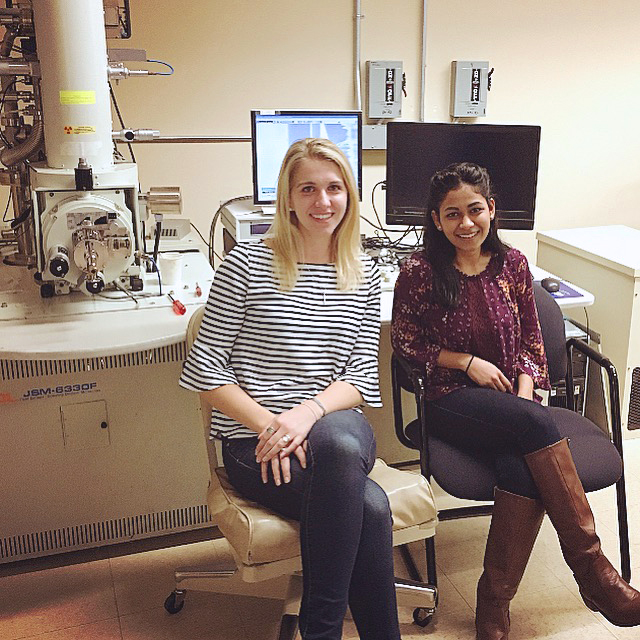Two MSE Undergraduate Students Push the Boundaries of Science for Space Exploration
By Amanda Olavarria

(From left to right) Amanda Giroux and Hetal Patel in front of Scanning Electron Microscope at Professor Lee’s laboratory.
MSE undergraduate students, Hetal Patel and Amanda Giroux recently co-authored a scholarly article about their research entitled ‘Superelasticity and Cryogenic Linear Shape Memory Effects of CaFe2As2, Nature Communications 1083 (2017)’. Hetal is a STEM Scholar and Amanda is a NSF-REU student (National Science Foundation- Research Experiences for Undergraduates).
This paper demonstrates the progress of research done in Assistant Professor Lee’s lab showcases the knowledge and dedication of both undergraduate students. Amanda and Hetal participated in the nanoindentation measurement of Young’s moduli and stress-strain curves of CaFe2As2 and LaRu2P2 single crystals in the summer of 2016 with Assistant Professor Lee as a part of his NASA project.
This research eventually led to a publication in Nature Communications. This study explores how the superelasticity of CaFe2As2 can be used as an actuator in extremely cold environments, like outer space. The results of the research indicate the possibility of creating cryogenic linear actuation technologies with high precision and high actuation power for space exploration.
The motivation for this study was deep space exploration. Creating devices like MEMS/NEMSs (Micro-/Nano-Electro-Mechanical Systems), actuators, and nano-sensors has been partly designed for space exploration, which requires the motion control of space telescope mirrors or robotic arms in extremely cold environments.
Both students are very proud to have been involved in this research. Amanda said, “I am honored to have been a part of Professor Lee’s laboratory and to work with the incredibly gifted team who have made this research successful.” Additionally, Hetal said, “Dr. Lee is truly an amazing educator, he understands the value of undergraduate research and I feel very lucky to be part of his lab and taking part on such an amazing and cutting edge research with numerous applications.”
Assistant Professor Lee is also very proud of their achievements. He says, “I am really happy to see that the results of their hard work are now officially available in a professional journal. They made a great contribution to this. It is always enjoyable for me to work with enthusiastic undergraduate students like Amanda and Hetal. This is just the beginning of their journey to the world of Materials Science. I hope that they find much more fun in Materials Science during their career!”
Currently, Hetal measures the maximum possible strength of metal before its permanent deformation by using spherical nanoidentation technique. She plans to do this by setting up an in situ nanomechanical cryogenic testing system and performing nanoindentation at low temperatures. She is studying the onset of permanent deformation of a widely used tungsten metal with the change in temperature and the change in spherical indenter size under a cryogenic environment using nanoidentation.
Amanda was a REU (Research Experience for Undergrads) participant two summers ago in the Lee laboratory. While there, she helped graduate students, John Sypek, Keith Dusoe, and Gyuho Song with their independent research on mechanical behavior of intermetallic compounds. This semester she is doing an independent study on hardness limits in bulk nanoceramics. Amanda is graduating in May 2018 and is considering pursuing a masters or doctorate in materials science. As for her interests within MSE, Amanda is fascinated with nanomaterials.
Both Amanda and Hetal have found their MSE experience to be very helpful to their successes within the field. Specifically, their publication has had a huge impact on their undergraduate career. This article was a major accomplishment for both Hetal and Amanda as they continue to dedicate themselves to pushing the boundaries of science.
Published: November 13, 2017
Categories: news, publications, research
Available Archives